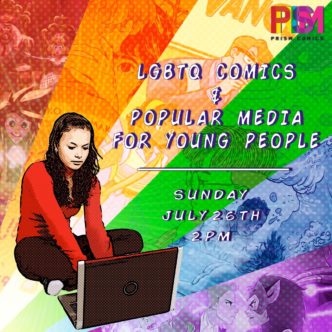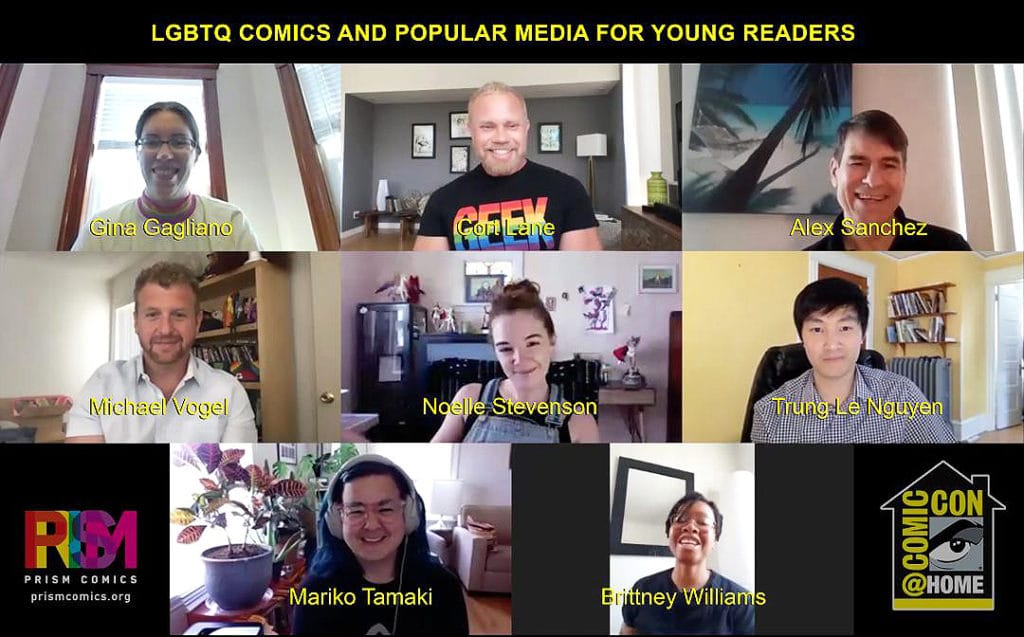The last panel (for me) of San Diego Comic-Con was LGBTQ Comics and Popular Media for Young People, moderated by Cort Lane.

I often say that one of my driving reasons behind this site is to make it easier for people to see themselves on TV. We all want, and deserve, representation, and for some of us it’s easier than others to find that fictionalized version of ourselves. But one place we all share the struggle is in youth oriented media.
To put it flatly, there are not a lot of LGBTQ+ tv shows for young people. In the US, this is directly related to the long standing censorship of television, where showing ‘happy’ queers wasn’t allowed until the late 80s/early 90s, and even then it had to start with coming-out stories. In fact, a number of stories are still about a young person coming to terms with their sexuality.
Now, there’s nothing wrong with that. It’s a fairly universal story in our heteronormative society. Most of us grew up in a world where being queer wasn’t seen, and it certainly wasn’t seen on cartoons and kids shows as a positive thing for a long time.
Thankfully times changed, shows evolved, but with very few exceptions it’s a struggle.
Unicorns and Ponies
Noelle Stevenson (She-Ra and the Princesses of Power) and Michael Vogel (My Little Pony: Friendship is Magic) had different versions of the journey to putting queer characters on their shows. On She-Ra, Stevenson basically convinced Netflix to product her friends-to-enemies-to-friends-to-lovers slow-burn fanfic. Meanwhile, Vogel had to ease in two characters who were barely non-coded, and only got away with it likely because the characters pre-existed in the comic.
In the panel, they talked about their journey (starting at roughly 11:34 in the video). I’ve included a transcript below the video.
Transcript
[…]
Cort Lane: I think it would be fair to say that, Noelle, you’ve had some of that experience yourself. Since we’re in animation now you — well congratulations on five absolutely triumphant seasons. Thank you. This is the power and this is almost a personal question for me, but I think it speaks the larger topic. For me after watching the five seasons and re watching them it occurred to me that again for me Catra is the most complex young queer character on television I’ve ever seen. The audience they start out hating her and then they begin to understand her and finally end up loving her and want happiness for her. That’s a massive arc so, as much as everyone’s an Adora fan, how do you how do you develop Catra as such a compelling queer character?
Noelle Stevenson: I had a big hunger for a type of character that I wasn’t really seeing in media. It’s kind of like Brittany said, you know, just like creating the work that you always wanted to see and and reflecting that however you can. I found myself gravitating towards a lot of characters who were really, really messy and they just have a lot of anger. I just saw this like kind of messy conflict wrapped up inside that character.
And most of time those characters were male and that was like the version of that character that people seem to be the most comfortable with, and I related a lot to this characters, especially when I was younger. But I noticed that when it came to female characters, people tended to go about like if they did something wrong even say mean or unpleasant in some way. People would be like “oh she reminds me of like a mean friend that I had,” and I was just like never — I want that kind of cathartic character that gets to be angry, gets to be messy, gets to just like have all these complicated emotions wrapped up in her.
And at the same time, I want this to be a lesbian romance that isn’t like super cute or like super fluffy all the time. I want it to be meaningful and I wanted to connect with people and for them to see themselves in it. So I ultimately want it to be positive, but I wanted it to have conflict and I wanted it to be a little bit of a just that kind of like dynamic relationship that I don’t think that we always get to see, especially with lesbian characters just because they are so rare. I think for Catra it just became a very like a very personal story honestly. Like I think there’s a catharsis and watching characters express the anger and express like that, just pure rage I think that’s not acceptable for us to express in our lives but like this has to go somewhere. So I think we can get that through watching fiction through through absorbing these stories and that can be something that it soothes a part of me at least to make that.
I think that the reaction to her character, it kind of shows that a lot of people see themselves in her. Most of us have not tried to destroy the world and that response to that anger. But to watch somebody who reflects that darkness in us, and then also watch her have a redemption arc and that she can get better and change, I think it’s important to show that, especially for young kids who might be wrestling with a lot of that themselves in their own lives
Cort Lane: That’s really beautiful and interesting. Staying on animation, Michael last year at this time during Pride Month you helped bring great characters Aunt Holiday and Auntie Lofty to the series My Little Pony Friendship is Magic. Can you talk about them and the publishing start for them, and how you brought them into television and in such a massive franchise like My Little Pony?
Michael Vogel: What was great about Pony is the relationship between the show and the fandom from the very get go was such that as the fandom sort of picked out background characters that they really liked, they would decide that these characters were a couple or those characters were a couple. Even though The Powers That Be maybe weren’t fully okay with going, there the storyboard artists would kind of do things in the background.
There were always these characters that were sort of background queer, which is something that any LGBTQ kid growing up sort of recognizes. It’s those characters that exist between the cracks, or are undefined in relationships, that we all relate to and are drawn to. Just getting those little steps where you get people comfortable, as frustrating as it is ,that’s something that you have to constantly try and push against and do.
When Nicole Dubuque and I were doing a publishing program for Hasbro with Little Brown called the Ponyville mysteries, there’s one of the characters — a popular character, one of the Cutie Mark Crusaders, Scootaloo — who like, who she lived with had never really been defined in the show. We kind of just asked if we could give her two aunts. And we got the permission so we did it which, first of all, trying to just trying to write very succinctly two women characters who are both aunts, who live together, and making it clear that they are a couple and not sisters is like — You’re like going over every word to make sure you get it right without going “actually this couple that lives here.” But we did it, people noticed it, it got some level of attention.
Fortunately when Nicole took over the show running duties for the final season with Josh Haber, since she and I had created those characters, she asked if she could bring them in, and they were in there. It’s kind of funny to me that this or any of these kind of like background characters parental figures would ever get so much attention in animation. It’s just it kind of speaks to the lack of diversity on this front that even having like a characters two aunts show up in the show for like a few minutes just caused this massive up swelling up. Like gay characters and Pony in the positive and the negative, but that was kind of the process.
It started in publishing into the series, and it was just a bunch of people who were part of the LGBTQ community, allies to the LGBTQ community, kind of like just continually pushing on that envelope to try and like just get it a little a little bit further. I think it’s really nice, although I wish that there is even more that could have been done on Pony. I think it’s nice that, as we like rounded out the final season of this iteration, we at least got the opportunity to have some out characters exist which is a struggle for a lot of people
Cort Lane: Not to make about me, but I had a similar experience on Marvel Rising, when we introduced America Chavez’s two moms. There was this social justice warrior backlash on social media that we didn’t really care about that much, but I regret that we couldn’t have done more. We sort of ran out of time and, not to like totally fangirl on a comic-con panel, but to Noelle. I think that there was this amazing moment, because as an animation executive watching She-Ra for the whole — I mean, from the get-go I was like “this is the gayest show I’ve ever seen on every level” and I loved everything about it.
There was always sort of this like “we’re gonna go right up to that edge and we’re not gonna go over it and without getting into any spoilers for people who haven’t seen She-Ra, although I don’t know why you wouldn’t have seen it all yet, by getting to the end of it and watching Catra and watching Adora and seeing how that all results — as a gay animation lover actually seeing those things that are constantly coded just kind of said out loud — I was not prepared for the emotional reaction that I would have to that, which I think just speaks to help. I mean, I’m an adult animation nerd, living and working in this industry, but to any kid, any queer kids sitting at home watching something like that — like just kudos to you it was amazing. I burst into tears I cried for a day.
[…]
